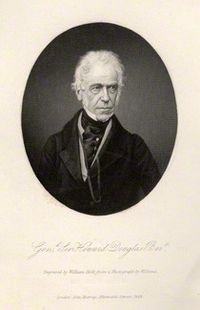Annotation:Lieutenant Howard Douglas: Difference between revisions
No edit summary |
No edit summary |
||
| Line 2: | Line 2: | ||
---- | ---- | ||
<p><font face="garamond, serif" size="4"> | <p><font face="garamond, serif" size="4"> | ||
'''LIEUTENANT HOWARD DOUGLAS.''' Scottish, Strathspey. D Major. Standard tuning (fiddle). AAB. Identified as a composition of Niel Gow, according to David Green and Phil Hresko, although Paul Cranford (1997) and others attribute it to Robert Mackintosh. There was a Lieutenant Howard Douglas, the son of Sir Charles Douglas who served at Quebec in 1776. In 1795 Douglas was the Officer in Charge of army personal on ''The Phyllis'', a transport carrying immigrants, soldiers' dependents and some army officers and men. The ship was wrecked off the bleak coast of Labrador, and the survivors made a harrowing escape to land where they were marooned for a winter until rescued. Douglas later became General Sir Howard Douglas [http://en.wikipedia.org/wiki/Howard_Douglas], 3rd Bart, a career office and administrator who served as Governor of New Brunswick (1823–31), and, later in life, as a Member of Parliament. | '''LIEUTENANT HOWARD DOUGLAS.''' Scottish, Strathspey. D Major. Standard tuning (fiddle). AAB. Identified as a composition of Niel Gow, according to David Green and Phil Hresko, although Paul Cranford (1997) and others attribute it to Robert Mackintosh. There was a Lieutenant Howard Douglas, the son of Sir Charles Douglas who served at Quebec in 1776. In 1795 Douglas was the Officer in Charge of army personal on ''The Phyllis'', a transport carrying immigrants, soldiers' dependents and some army officers and men. The ship was wrecked off the bleak coast of Labrador, and the survivors made a harrowing escape to land where they were marooned for a winter until rescued. Douglas later became General Sir Howard Douglas [http://en.wikipedia.org/wiki/Howard_Douglas], 3rd Bart, a career office and administrator who served as Governor of New Brunswick (1823–31), and, later in life, as a Member of Parliament. | ||
[[File:howarddouglas.jpg|200px|thumb|left|Sir Howard Douglas, Bart.]] | |||
<br> | <br> | ||
<br> | <br> | ||
Revision as of 21:43, 29 October 2012
Back to Lieutenant Howard Douglas
LIEUTENANT HOWARD DOUGLAS. Scottish, Strathspey. D Major. Standard tuning (fiddle). AAB. Identified as a composition of Niel Gow, according to David Green and Phil Hresko, although Paul Cranford (1997) and others attribute it to Robert Mackintosh. There was a Lieutenant Howard Douglas, the son of Sir Charles Douglas who served at Quebec in 1776. In 1795 Douglas was the Officer in Charge of army personal on The Phyllis, a transport carrying immigrants, soldiers' dependents and some army officers and men. The ship was wrecked off the bleak coast of Labrador, and the survivors made a harrowing escape to land where they were marooned for a winter until rescued. Douglas later became General Sir Howard Douglas [1], 3rd Bart, a career office and administrator who served as Governor of New Brunswick (1823–31), and, later in life, as a Member of Parliament.

Source for notated version: Winston Fitzgerald (1914-1987, Cape Breton) [Cranford].
Printed sources: Cranford (Winston Fitzgerald), 1997; No. 139, p. 56.
Recorded sources: Philo 2001, "Jean Carignan." Rounder 7001, Joe Cormier - "Scottish Violin Music from Cape Breton Island" (1974). Puirt a Baroque - "Kinloch's Fantasy."
See also listing at:
Alan Snyder's Cape Breton Fiddle Recordings Index [2]
Hear the 78 played by Bill Lamey at the Internet Archive [3] [4] (first tune in medley, followed by "Forest of Gaick (The)" and "Mrs. Stewart of Garth")
Back to Lieutenant Howard Douglas
